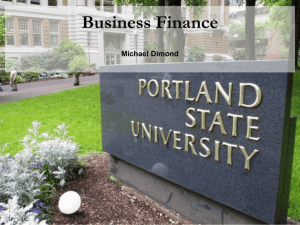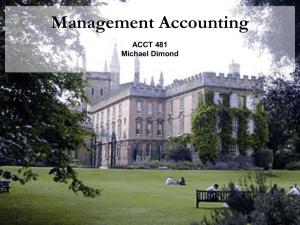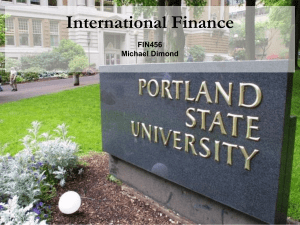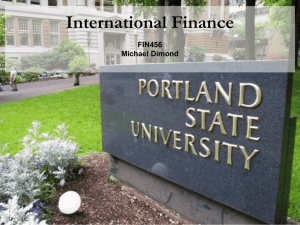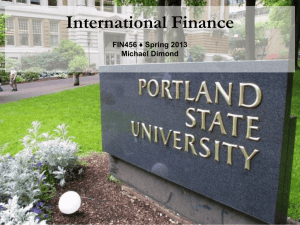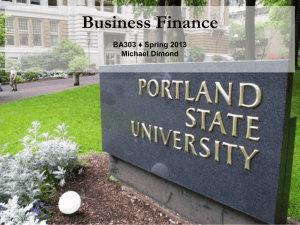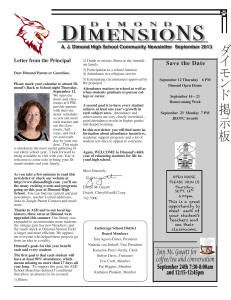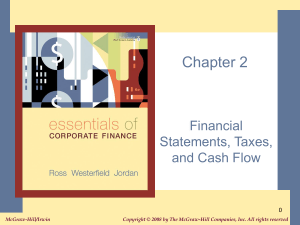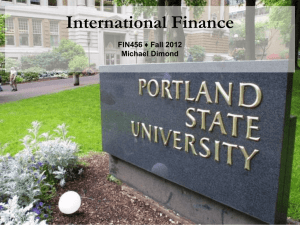Cash Flows & Valuation
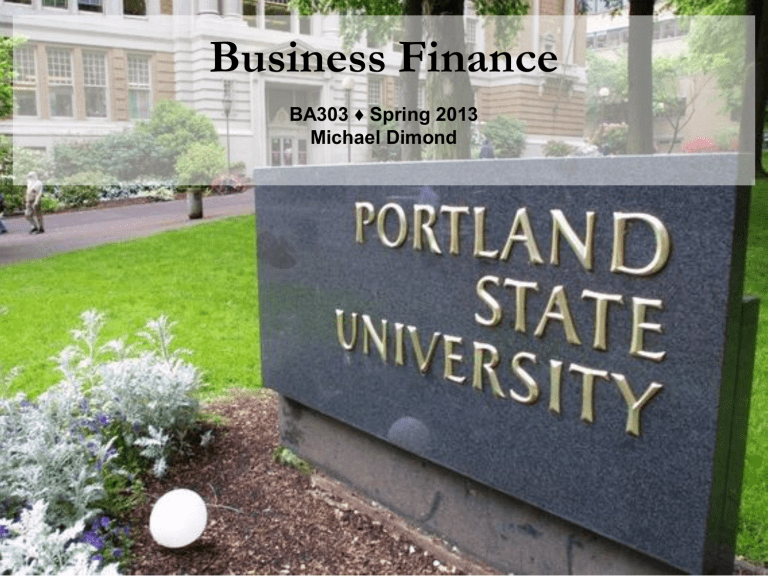
Business Finance
BA303 ♦ Spring 2013
Michael Dimond
Module F: Cash Flows & Valuation
• Big module
• Start HW early so you have time to digest the topics
• I recommend you stop when you get to the big, comprehensive problems.
We’ll be working on these in class, which will make the HW easier.
Michael Dimond
School of Business Administration
Discounting the cash flows is the easy part…
• Computing the correct cash flow is a little more complicated.
• Trying to accurately predict the future (plus or minus a little )
• Trying to use accounting figures to show economic reality
• You must understand what the number represents and what went into it before you can present an accurate valuation.
• Remember the financial statements?
• Income statement
• Balance sheet
• Statement of cash flows
• You will be computing cash flows…
• from financial statements to evaluate existing businesses
• from pro forma financials to evaluate proposals and scenarios
• You may need to measure sensitivity to certain inputs
• What if sales or costs are less than (or more than) expected?
• What if growth is less than (or more than) expected?
Michael Dimond
School of Business Administration
What CF do stockholders really buy?
• Dividend?
• Net Income?
• Free Cash Flow?
• To understand cash flow, you must understand financial statements and what the figures represent
Michael Dimond
School of Business Administration
Cash Flows
• NOPAT = Net Operating Profit After Taxes
EBIT(1-t)
• OCF = Operating Cash Flow
NOPAT + Depreciation Expense
NI + Interest + Depreciation Expense
• NOTE: Operating Cash Flow is not the same as Cash Flow from Operations
• FCF = Free Cash Flow
OCF – Net Cash Investment in Operating Capital
• Free Cash Flow: The cash generated which is available to satisfy the needs of lenders and the wants of investors.
• FCFE = Free Cash Flow for Equity
FCF – Net Cash Flow to Debt
• Free Cash Flow to for Equity: The cash generated which is available to satisfy the wants of investors.
Michael Dimond
School of Business Administration
Working with financial statement data
• Accounting figures are distorted for several reasons
• Rules & laws
• Assumptions & “Generally Accepted Accounting Principles”
• Inaccuracies & manipulations
• Financial Analysis tries to get those numbers to represent economic reality
• Non-cash “expenses”
• Categorization of revenues and expenses
• Operating Cash Flow (OCF) is the basic starting point of all valuation efforts
• Need to understand the figures being used
• OCF = NOPAT + Depreciation Expense
• NOPAT = EBIT(1-t)
• :. OCF = EBIT(1-t) + Depreciation Expense
Michael Dimond
School of Business Administration
EBIT
• Given a bunch of financial data, how do you compute EBIT?
• Top down or bottom up?
• Bottom up is easier to remember
• Top down helps you understand better
• Building a pro forma income statement
Michael Dimond
School of Business Administration
Tax Rate
• Tax expense ÷ EBT (Earnings Before Taxes)
• EBT is also called Net Profit Before Taxes
• Average tax rate
• Marginal tax rate
• Typical tax rates in finance problems will be 34%, 35% or 40%. This is not true in real life.
Michael Dimond
School of Business Administration
Depreciation
• What is depreciation?
• Straightline vs MACRS
• Why do we adjust for depreciation when computing OCF?
• What about other non-cash expenses?
Michael Dimond
School of Business Administration
Operating Cash Flow (OCF)
• EBIT = …
• NI + Tax + Interest
• Sales – Direct Costs – Indirect Costs – Depreciation
• Sales – Total Variable Costs – Total Fixed Costs – Depreciation
• Tax rate = …
•
Might be given (e.g. 34%, 35%, 40%)
• Might be derived from Tax ÷ EBT
•
EBT = EBIT - Interest
• NOPAT = EBIT(1-t)
• OCF = NOPAT + Depreciation Expense
Michael Dimond
School of Business Administration
Michael Dimond
School of Business Administration
Michael Dimond
School of Business Administration
Michael Dimond
School of Business Administration
Operating Cash Flow (OCF)
• From the income statement
• EBIT x (1-t) + Depreciation = OCF
• 370 x (1-0.4) + 100 = 322
Michael Dimond
School of Business Administration
OCF
→
FCF
• FCF = Free Cash Flow
• Free Cash Flow: The cash generated which is available to satisfy the needs of lenders and the wants of investors.
OCF – Net Cash Investment in Operating Capital
• What is operating capital?
• Assets used for operating purposes
• Not financial assets
• Operating assets can be classified as Fixed Assets and Current Assets
• Fixed assets are normally capitalized, so depreciation is involved
• Current Assets are also called Working Capital. We really care about Net Working
Capital
• Net Working Capital is Current Assets – Current Liabilities
• Are all current liabilities operating items?
• NWC for our purposes will be limited to operating items only, so…
NWC = Current Assets
– (Accounts Payable + Accruals) which should be the same as
NWC = Current Assets – (Current Liabilities – Non-operating CLs)
Michael Dimond
School of Business Administration
OCF
→
FCF
• OCF – Δ NFA – Δ NCA = FCF
• 322 – 300 – 0 = 22
• Fixed Assets increased
200, and depreciation was 100, so
Δ NFA = 300
• How much did current assets change?
• How much did AP &
Accruals change?
Michael Dimond
School of Business Administration
OCF
→
FCF
• OCF – Δ NFA – Δ NCA = FCF
• 322 – 300 – 0 = 22
• Current Assets increased 100, so
Δ CA = 100
• CL
OP
(AP + Accruals) was
700 in 2011 and
800 in 2012, so
Δ CL
OP
= 100
• We need the Net amount, so we subtract:
Δ CA - Δ CL
OP
= Δ NCA
100 - 100 = 0
Michael Dimond
School of Business Administration
Capital Budgeting Decisions
• To make an objective business decision, we have to understand the scenario, the relevant cash flows, the change in cash flow caused by the decision, and the net present value of those incremental cash flows.
• At its simplest, it might be like this capital budget proposal:
Initial Investment
Incremental CF
Terminal Value
Total CF
PV
NPV (Sum of PVs, less Initial Investment)
IRR
PBP
9% Hurdle Rate
YEAR 0
(1,110,400)
(1,110,400)
(1,110,400.0000)
100,900.3907
12.24%
3.91
257,200
257,200
235,963.3028
1
344,400
344,400
289,874.5897
2
274,200
274,200
211,732.7102
3
258,800
258,800
183,340.4446
4
274,800
172,000
446,800
290,389.3434
5
• Is life ever that simple?
Michael Dimond
School of Business Administration
Capital Budgeting Decisions
• More realistically, it will be something like this:
• (based on P11-29)
• Holliday Manufacturing is considering the replacement of an existing machine.
The new machine costs $1.2 million and requires installation costs of
$150,000. The existing machine can be sold currently for $185,000 before taxes. The old machine is 2 years old, cost $800,000 when purchased, and has a $384,000 book value and a remaining useful life of 5 years. It was being depreciated under MACRS using a 5-year recovery period, so it has the final 4 years of depreciation remaining. If it is held for 5 more years, the machine’s market value at the end of year 5 will be zero. Over its 5-year life, the new machine should reduce operating costs by $350,000 per year, and will be depreciated under MACRS using a 5-year recovery period. The new machine can be sold for $200,000 net of removal and cleanup costs at the end of 5 years. A $25,000 increase in net working capital will be required to support operations if the new machine is acquired. The firm has adequate operations against which to deduct any losses experienced on the sale of the existing machine. The firm has a 9% cost of capital and is subject to a 40% tax rate.
Should they accept or reject the proposal to replace the machine?
Michael Dimond
School of Business Administration
Capital Budgeting Decisions
• Step 1:
Michael Dimond
School of Business Administration
Break a complicated problem into smaller pieces
• To make an objective capital budget decision, we have to understand the scenario, the relevant cash flows, the change in cash flow caused by the decision, and the net present value of those incremental cash flows.
• Scenario
• Invest in replacement machine (Proposal) or stick with old machine (BAU)
• Relevant Cash Flows
• Initial investment (net cost to acquire and install the new machine)
• Annual net benefit
• Terminal value (What the new machine will be worth at the end of the timeline)
• Incremental Cash Flows (ie, what changes because of the decision?)
• Compare the relevant CFs to the Business-As-Usual (BAU) CFs
• DCF Analysis (the easy part)
• Discount the incremental cash flows at the hurdle rate
• Objective Decision
• Positive NPV, IRR > Hurdle Rate, Acceptable Payback Period
Michael Dimond
School of Business Administration
Scenario
• How long is the timeline?
• What happens, and when?
Proposal:
0 1 2
Sell old machine
Buy new machine
Install new machine
Increase NWC needs
Reduced
Operating
Costs
Reduced
Operating
Costs
3
Reduced
Operating
Costs
4 5
Reduced
Operating
Costs
Reduced Op. Costs
Sell “new” machine
Reduce NWC needs
Michael Dimond
School of Business Administration
Relevant Cash Flows
• What are the cash inflows and outflows?
Proposal:
0 1
Sell old machine
Buy new machine
Install new machine
Increase NWC needs
Reduced
Operating
Costs
2
Reduced
Operating
Costs
3
Reduced
Operating
Costs
4 5
Reduced
Operating
Costs
Reduced Op. Costs
Sell “new” machine
Reduce NWC needs
Michael Dimond
School of Business Administration
Initial Investment
• Sell old machine
• $185,000 before taxes
• Gain or loss on sale of asset?
• Proceeds – Book Value = Gain or (Loss)
• What was the book value? $384,000
• 185k – 384k = (199k)
• Tax Rate x Gain or (Loss) = Tax Effect
• 40% x ($199,000) = ($79,600) :. The company will pay less tax because of the loss.
• After-tax Proceeds = $185,000 – ($79,600) = $264,600
• Buy New Machine
• $1,200,000
• Install new machine
• $150,000
• Increase NWC (Net Working Capital) needs
• $25,000
Michael Dimond
School of Business Administration
• (based on P11-29)
• Holliday Manufacturing is considering the replacement of an existing machine.
The new machine costs $1.2 million and requires installation costs of
$150,000. The existing machine can be sold currently for $185,000 before taxes. The old machine is 2 years old, cost $800,000 when purchased, and has a $384,000 book value and a remaining useful life of 5 years. It was being depreciated under MACRS using a 5-year recovery period, so it has the final 4 years of depreciation remaining. If it is held for 5 more years, the machine’s market value at the end of year 5 will be zero. Over its 5-year life, the new machine should reduce operating costs by $350,000 per year, and will be depreciated under MACRS using a 5-year recovery period. The new machine can be sold for $200,000 net of removal and cleanup costs at the end of 5 years. A $25,000 increase in net working capital will be required to support operations if the new machine is acquired. The firm has adequate operations against which to deduct any losses experienced on the sale of the existing machine. The firm has a 9% cost of capital and is subject to a 40% tax rate.
Should they accept or reject the proposal to replace the machine?
Michael Dimond
School of Business Administration
Terminal Value
• Terminal Value
• Terminal value is the is the remaining value a project has after the intermediate cash flows have all happened.
• Terminal Value is sometimes called residual value. On a capital project, it might be called salvage value.
• Sell “new” machine after year 5
• $200,000 before taxes
• Gain or loss on sale of asset?
• Proceeds – Book Value = Gain or (Loss)
• What was the book value? $67,500
• 200k – 67.5k = 132.5k Gain
• Tax Rate x Gain or (Loss) = Tax Effect
• 40% x $132,500 = $53,000 :. The company will pay more tax because of the gain.
• After-tax Proceeds = $200,000 – $53,000 = $147,000
• Decrease NWC needs
• $25,000
Michael Dimond
School of Business Administration
Book Value of “new” machine after 5 years
• Cost = $1,350k
Remember, this includes cost + installation
• D1 = 270 k (20%)
• D2 = 432 k (32%)
• D3 = 256.5k (19%)
• D4 = 162 k (12%)
• D5 = 162 k (12%)
• BV = $67.5k
Michael Dimond
School of Business Administration
Relevant Cash Flows
• What are the cash inflows and outflows?
Proposal:
0 1 2 3 4 5
Sell old machine
Buy new machine
Install new machine
Increase NWC needs
Reduced
Operating
Costs
Reduced
Operating
Costs
Reduced
Operating
Costs
Reduced
Operating
Costs
Reduced Op. Costs
Sell “new” machine
Reduce NWC needs
$264,600 Inflow
$1,200,000 Outflow
$150,000 Outflow
$25,000 Outflow
_________________
Io = $1,110,400
Outflow
$147,000 Inflow
$25,000 Inflow
__________________
TV = $172,000
Inflow
$350k $350k $350k $350k
• Is that all?
• We also need to consider the effect which depreciation has on tax expense.
$350k
Michael Dimond
School of Business Administration
Relevant Cash Flows
• Depreciation is a non-cash expense, but it does have an effect on tax expense (therefore depreciation has an effect on a cash flow).
CF for New Machine
Reduction in Operating Cost
Depreciation
Net Profit before Tax
Tax (@40%)
Net Profit After Tax
Operating Cash Flow
YEAR 0
350,000
270,000
1
80,000
32,000
48,000
318,000
350,000
432,000
2
(82,000)
(32,800)
(49,200)
382,800
350,000
256,500
3
93,500
37,400
56,100
312,600
350,000
162,000
4
188,000
75,200
112,800
274,800
350,000
162,000
5
188,000
75,200
112,800
274,800
Michael Dimond
School of Business Administration
Incremental Cash Flows
• What & when would the BAU cash flows be?
• No cost savings
• What about the effect which depreciation would have had on tax expense?
• What salvage value would the existing (BAU) equipment have after year 5?
CF for Old Machine
YEAR 0 1 2 3 4 5
Depreciation
Net Profit before Tax
Tax (@40%)
Net Profit After Tax
Operating Cash Flow
152,000
(152,000)
(60,800)
(91,200)
60,800
96,000
(96,000)
(38,400)
(57,600)
38,400
96,000
(96,000)
(38,400)
(57,600)
38,400
40,000
(40,000)
(16,000)
(24,000)
16,000
-
-
-
-
-
• What is the difference between BAU and the proposal cash flows?
Incremental CF
New Machine CF
Old Machine CF
Incremental CF (Difference)
YEAR 0
318,000
60,800
257,200
1
382,800
38,400
344,400
2
312,600
38,400
274,200
3
274,800
16,000
258,800
4
274,800
-
274,800
5
Michael Dimond
School of Business Administration
DCF analysis
• What is the hurdle rate?
• 9.0%
• What/when are the incremental cash flows?
Initial Investment
Incremental CF
Terminal Value
Total CF
PV
NPV (Sum of PVs, less Initial Investment)
IRR
PBP
9% Hurdle Rate
YEAR 0
(1,110,400)
(1,110,400)
(1,110,400.0000)
100,900.3907
12.24%
3.91
257,200
257,200
235,963.3028
1
344,400
344,400
289,874.5897
2
274,200
274,200
211,732.7102
3
258,800
258,800
183,340.4446
4
274,800
172,000
446,800
290,389.3434
5
Michael Dimond
School of Business Administration
Objective decision
• Do the incremental cash flows have a positive NPV?
• Yes, $100,900
• Is the IRR greater than the hurdle rate?
• Yes, 12.2% > 9.0%
• Is the payback period acceptable?
• Depends on what management says about PBP, but NPV and IRR should be used to make the actual decision. I use PBP just to show a complete picture.
Initial Investment
Incremental CF
Terminal Value
Total CF
PV
NPV (Sum of PVs, less Initial Investment)
IRR
PBP
9% Hurdle Rate
YEAR 0
(1,110,400)
(1,110,400)
(1,110,400.0000)
100,900.3907
12.24%
3.91
257,200
257,200
235,963.3028
1
344,400
344,400
289,874.5897
2
274,200
274,200
211,732.7102
3
258,800
258,800
183,340.4446
4
274,800
172,000
446,800
290,389.3434
5
Michael Dimond
School of Business Administration
What else can we do with valuation?
• The decision is not always, “should we do this or not.”
Sometimes the decision is “which alternative should we choose?” For example:
• Should we lease or buy an asset?
• Should we make a component or buy a component?
• Sometimes the reason we value something is for investment purposes
• What is this stock worth, and why ?
• Should we buy this stock? Should we sell? Should we wait?
Michael Dimond
School of Business Administration
Lease vs Buy Decision – Lessee’s POV
• To make an objective lease-vs-buy decision, you need to compute the Net Advantage to Leasing (NAL).
• The Net Advantage to Leasing is the cost of ownership minus the cost of leasing
• Cost of ownership is the PV of the purchase scenario
• Cost of leasing is the PV of the leasing scenario
• NAL = PV own
– PV lease
Michael Dimond
School of Business Administration
Lease vs Buy Decision – Lessee’s POV
• Example: 2-year Asset Lease vs Buy Decision
Year 0
Cost of Owning
Equipment cost
Loan amount
Interest expense
Tax savings from interest
Principal repayment
Tax savings from depreciation
$ (100.000)
$ 100.000
Net cash flow
PV @6%
Cost of ownership
$ -
$ (63.332)
$ 63.332
Year 1
$ (10.000)
$ 4.000
$ 20.000
$ 14.000
Year 2
$ (10.000)
$ 4.000
$ (100.000)
$ 20.000
$ (86.000)
Cost of Leasing
Lease payment
Tax savings from lease
Net cash flow
PV @ 6%
Cost of leasing
Cost of ownership
Cost of leasing
NAL
$ -
$ (60.502)
$ 60.502
$ (55.000)
$ 22.000
$ (33.000)
$ (55.000)
$ 22.000
$ (33.000)
$ 63.332
$ 60.502
$ 2.830
Michael Dimond
School of Business Administration
Make vs Buy Decision
Michael Dimond
School of Business Administration
What CF do stockholders really buy?
• Dividend?
• Net Income?
• Free Cash Flow?
• To understand cash flow, you must understand financial statements and what the figures represent
• Module G: Financial Statement Analysis
Michael Dimond
School of Business Administration
